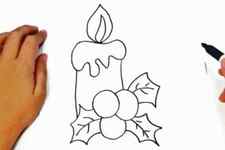As you explore, feel free to mix and match elements – perhaps a leaf with the elongated body of a willow leaf but with the serrated edges of a birch leaf.
Drawing leaves: How to draw step by step – Doodle a leaf

Learn how to draw leaves step by step in this tutorial where we will go from super simple and easy, to drawing specific leaves by name. We will cover the basics and parts of a leaf and go into step-by-step doodles from imagination to using a real leaf found in nature as a reference for our drawings. So today you will learn 25+ different leaves for your bullet journal or project.

Learning how to draw leaves is really simple when you have a step-by-step tutorial on hand. It’s actually easier to do it this way and not from a video, because you don’t have hit the pause button all the time. Everything you need to know is there right in front of you.
In this tutorial, we will cover Leaf Drawing 101:
- The basic parts of a leaf
- Step-by-step leaf doodling
- Imaginary leaves vs. realistic leaves
If you want to master how to draw 25+ leaves – whether to decorate your bullet journal or to illustrate a project – this is the perfect learning forum for you!
In this post, I will cover
- Parts of a leaf
- Drawing supplies
- How to doodle leaves
- How to draw a simple leaf
- Drawing a Ginkgo leaf
- Drawing a Red Maple leaf
- Drawing an Ivy leaf
- Drawing a Sugar Maple leaf
- Drawing a Red Oak leaf
- Drawing a Silver Maple leaf
- Drawing a Bur Oak leaf
- Drawing an Ash leaf
- Drawing additional leaves
- Using your leaves, more posts for you!
Parts of a leaf
While I don’t want to make things too complicated when it comes to drawing leaves, I do think that is important to know all the part of a leaf in case you want to get more detailed and want to make them look as realistic as possible.
If you do want to go the realistic way with your colors and details of the drawing, knowing the parts is essential. If you want to create simple drawings or just very easy doodles, is still good to know some basics of leaves, so we can capture the essence of the shape.


- Stem: A stem is basically the plant’s support system. The stem is the tiny stick part that connects the leaf to the branch and thereby providing the leaf with a structure to which it is attached.
- Axil: The axil is the upper angle between a leaf and the stem to which it is attached. The axil is the part that connects the petiole to the stem. It always connects at an angle.
- Leaf base: Pretty self-explanatory – the leaf base is the lowest edge of the leaf. It is the lowest part of the leaf connecting to the petiole. Sometimes has similar contours to the cupid’s bow part of a heart shape or an archery bow.
- Petiole: It is the stalk that connects a leaf to the stem of the plant or branch.
- Leaf-blade: Also called the lamina (Latin for thin slice/layer/leaf). This part of the leaf needs to be thin and flat to aid the leaf’s aerodynamic properties.
- Leaf lobe: The partially separate section/s found in some leaf types. It is distinct from the main part of the leaf with an indentation, called a sinus, and can break the leaf shape all the way to the mid rib, as in the case of very deep lobes. The leaf’s continuity of structure can sometimes include serrated (sharpened spike points) or rounded lobes, with the number of formed lobes varying from two lateral lobes all the way up to countless leaf lobes. The lobes are considered by some artists to be the most defining characteristic of a leaf when it is drawn in more detail.
- Vein: Just the same as the veins in our bodies, only leaf veins transport essential nutrients and water from the roots to the leaf, and carry away photosynthesized by-products.
- Leaf margin: The leaf’s outline.
- Venules: These are the smaller veins on a leaf.
- Midrib: The most identifiable part of leaf structure and often the only part of a leaf we draw when sketching a basic leaf form, the midrib runs from the petiole to the leaf tip. A lot like the leaf’s backbone.
- Tip: Most leaves have a tip; it’s the pointy end of the leaf, similar in design to the point of a heart shape. Even if the leaf appears to be completely round, it will still have a tip.
Drawing supplies
You can start drawing and doodling no matter the kind of supplies you have around your house, unlike when we are doing lettering or brush calligraphy, you can start with just about anything!
Now, of course, you can start practicing lettering with any supplies as well, but when you do brush calligraphy you need a tool that will allow you to create thin and thick lines depending on the pressure.
Since when we draw all we need is a monoline pen or pencil (monoline means the same thickness no matter the pressure or angle we use) we are good with whatever. BUT! Since I loooove office supplies, I do want to share some of my favorites and some extra tools that would help you take your doodling to the next level!
Oh, also, if you are looking for sketching paper, this HP paper rem that I recommend to start using with Brush Calligraphy is also wonderful for doodles, you can also use tracing paper to create “layers” and correct your drawings. I also recommend this journal in case you don’t have one, and this notebook in case you want to add watercolor details or you want to make sure there’s no bleeding on your pages since you can color and sketch on both sides of the pages, it’s awesome, get it here!.
If you want to work on your iPad instead, here you can see a list of my current digital drawing setup and recommendations. Also, here you can read all about the Procreate brushes I use and recommend.
How to Draw 5 Different Types of Leaves
We are excited to share with you a delightful addition to your autumn activities – a printable, step-by-step guided drawing PDF that introduces your children to the art of leaf drawing.
Spread across 5 pages, it features 5 different leaves, helping kids not only to observe and appreciate the intricate details but also to recreate them on paper.
How to Draw an Oak Leaf
Sketching an oak leaf? Start with a small, elongated shape for the base, and then draw scalloped edges with rounded lobes to get that classic, robust oak leaf form.
The lobes create a wavy perimeter that adds a rustic charm to your drawing.

How to Draw a Laburnum Leaf
To draw a laburnum leaf, start with a central stem and sketch three elongated, slightly oval leaflets emerging from a single point, forming a trifoliate pattern. The individual leaflets are generally long, with smooth edges, tapering to a point at the tip.
Keep the lines smooth and the angles rounded to capture the graceful growth pattern of laburnum leaves. Remember, the central leaflet is slightly longer than the ones on the sides, giving it a distinctive, symmetrical appearance.





